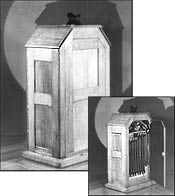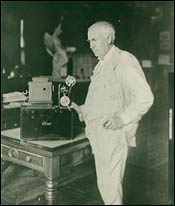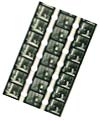November 1999
|
"I am experimenting upon an instrument which does for the Eye what the phonograph does for the Ear." -- Thomas Edison, caveat #110, October 17, 1888
Over one hundred years ago, Thomas A. Edison conceived of moving pictures as home entertainment. Experiments on the Kinetograph (camera to take moving pictures) and the Kinetoscope (machine to view moving pictures) began in 1888, when Edison directed his team of experimenters to make his idea a reality. |
|
The first commercially
successful Kinetoscope was a peepshow where one person at a time
could look at the motion pictures for about 15 seconds. Each machine
cost several hundred dollars and like Edison's first Phonograph, was
used at coin-operated arcades in cities and amusement parks. Edison
thought that once people saw this marvel they would want to look
at moving pictures in their home parlors, just like people eventually
bought Phonographs for home use. For a nickel per view, people
could see short action skits of dancers, boxers, circus performers, comedians, and other novelty acts. Edison's company filmed about 135 different shows, but the most popular was "Fred Ott's Sneeze" featuring his employee.
Although Edison's original idea was to have pictures shown with the Phonograph's sound, only a few of the first Kinetoscope peepshow machines had a Phonograph that played music and sound effects along with the pictures. The sound was not coordinated with specific actions in the movie.
Over 900 Kinetoscope peepshow machines were sold from 1894 to 1895. They could be found in arcades and Kinetoscope parlors for another ten years. But Edison's vision of Kinetoscopes in homes was not realized as people preferred to see motion pictures projected on a screen.
|

Edison
Kinetoscope peepshow housed in a wood cabinet four feet high, with
the viewing eyepiece on top and a fifty foot loop of film inside.
Date: ca. 1894, ID 36.753.1 |

Edison
Kinetoscope film, 35-mm width with four perforations on each side.
Date: 1895, Title:The Butterfly Dance, ID 36.753.2 |
Edison next
had his staff work on a Projecting Kinetoscope that showed moving
pictures on a screen. Other inventors had started experimenting
with these machines, but Edison bought the rights to patents and
developed his own. Starting in 1897, the Projecting Kinetoscope
was used in small movie houses throughout the United States where
groups of about 100 people could see the movies lasting about 16 minutes. They usually
paid five cents, a nickel, to see the show, and by 1905 the theatres
became known as Nickelodeons. |
| From 1913 to 1916, Edison's projector was synchronized with a special Phonograph that he called a Kinetophone. It provided the sound of voices and special effects coordinated with the action of the movie. This proved difficult to keep the Phonograph and the projector working together correctly. So, many theatre owners decided to stick with projectors of the usual silent pictures. By 1918 the Edison Company was spending two dollars for every one dollar they earned on their projectors and they decided to discontinue them.
|

Edison
Projecting Kinetoscope.
Date: ca. 1913, ID 29.460.14 |

Thomas A. Edison with his Home Projecting Kinetoscope. Date: ca. 1912, ID P.188.9731
The museum's collection has a Home PK much like this one. ID 63.85.1

Edison
Home Projecting Kinetoscope film, 22-mm in width with three frames
across. Made on non-flammable film stock called Safety film developed
by Eastman Kodak and supplied to Edison for the Home PK. Date:
ca. 1913, Title: Professor and the New Hat, ID 63.85.3
|
While manufacturing projectors for movie houses, Edison still had the idea that people would really want to see moving pictures in their home. In 1912 his company started to make Home Projecting Kinetoscopes. Each home projector cost between $75 and $100 which was quite expensive for individuals to buy.
Owners could rent over 230 movies from the Edison Company. Most were copies of films made for the theatre Projecting Kinetoscope and were about 16 minutes in length. Ranging in topics from dramas to comedies to educational subjects, these films cost about $20 each and could be exchanged for another film through the mail. But because of their unique format, these projectors were not very popular as they could only show films made by Edison.
The Edison Company manufactured over 4,600 Home Projecting Kinetoscopes, but only about 500 projectors were sold from 1912 to 1914. This was not enough to make a profit for Edison's Company, so they too were discontinued.
Although Edison decided that moving pictures as home entertainment was not a viable commercial enterprise, if he were alive today he would appreciate the success of videotape rentals of movies for home televisions.
See Edison's 1890 Kinetoscope parlor recreated in in the the museum's new IMAX Theatre's pre show-film!
|
[ Pic of the Month ] [ Pic Archive ]
|

